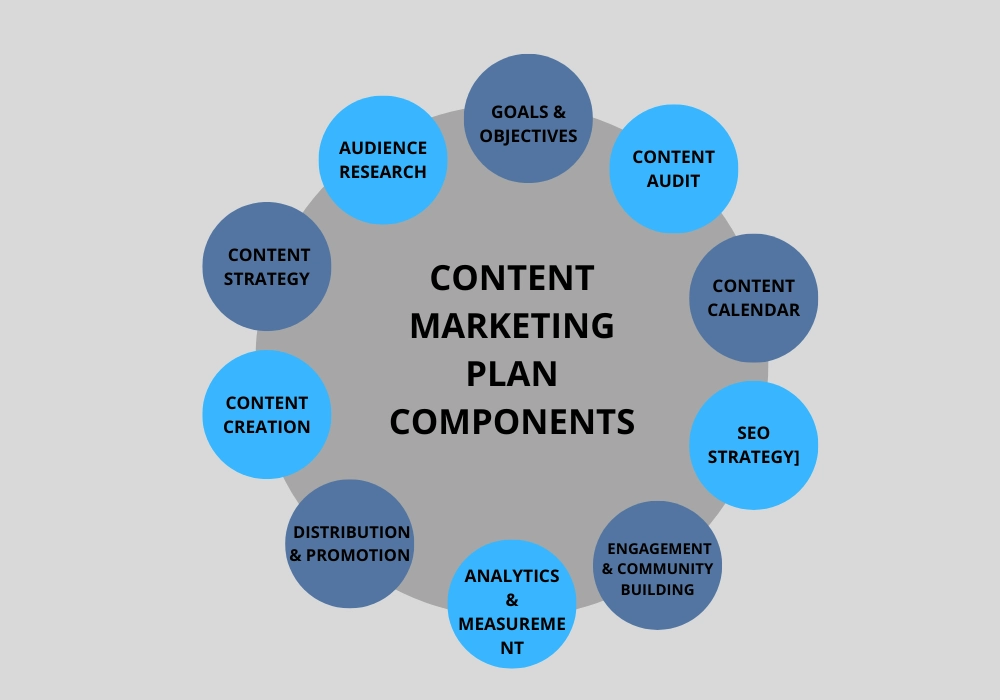In today’s digital landscape, content is king. But simply churning out blog posts, social media updates, or videos isn’t enough to capture and hold the attention of your audience. You need a well-thought-out content strategy to guide your efforts. So, what exactly are the components of a successful content strategy? Let’s dive into the essential elements you need to consider.
What is a Content Marketing Strategy?
A content marketing strategy involves a meticulous blueprint outlining the creation, distribution, and oversight of content aimed at captivating, interacting with, and converting a distinct audience segment. It involves understanding the audience’s needs and preferences, setting clear business objectives, developing a content plan, producing high-quality and valuable content, optimizing it for search engines, distributing it through appropriate channels, engaging with the audience, and continuously analyzing and improving the approach to achieve desired results. The ultimate aim is to drive profitable customer actions and build lasting relationships with the audience through consistent and meaningful content.
Components of a Successful Content Marketing Strategy
Let's break down the essential elements of a successful content marketing strategy:
Understand Your Audience
Central to a successful content marketing strategy is a profound comprehension of your audience. It’s crucial to delve into who they are: their challenges, passions, and requirements. Employing tools such as Google Analytics, social media analytics, and direct customer feedback surveys enables you to gather invaluable insights. Developing well-defined buyer personas allows you to vividly portray your ideal customers, empowering you to craft content that deeply resonates with their preferences and priorities.
Set Clear Goals
What are your primary goals for your content marketing strategy? Whether it’s increasing brand awareness, driving traffic to your website, generating leads, or boosting sales, setting clear, measurable goals is essential. Having specific objectives will guide your content creation process and help you track your success.
Develop a Content Plan
A well-thought-out content plan acts as a roadmap for your marketing efforts. Start by brainstorming topics that align with your audience’s interests and your business goals. Consider creating a content calendar to schedule your posts, ensuring a consistent and strategic approach. Mix up your content types—blogs, videos, infographics, podcasts, and social media updates—to keep your audience engaged.
Create High-Quality, Valuable Content
Quality trumps quantity every time. Your content should offer real value to your audience, whether it’s through informative articles, entertaining videos, or insightful infographics. Focus on creating original, well-researched content that solves problems, answers questions, and provides useful information. High-quality content not only attracts readers but also encourages them to share it, extending your reach.
Optimize for SEO
Search engine optimization (SEO) is crucial for ensuring your content is discoverable online. Use keyword research tools to identify relevant keywords and phrases your audience is searching for, and incorporate them naturally into your content. Pay attention to on-page SEO elements like meta titles, descriptions, headers, and image alt text. Additionally, producing long-form content that is comprehensive and well-structured can improve your search rankings.
Promote Your Content
Once you’ve crafted compelling content, the next crucial step is effective promotion. Spread your content strategically across social media platforms, email newsletters, and niche online communities. Collaborating with influencers and respected figures in your industry can significantly extend your content’s reach. Additionally, consider repurposing your content into diverse formats to cater to different segments of your audience, maximizing engagement and resonance.
Engage with Your Audience
Content marketing is not a one-way street. Engage with your audience by responding to comments, answering questions, and participating in discussions. Building a community around your brand fosters loyalty and encourages more interactions with your content. User-generated content, such as reviews and testimonials, can also enhance your credibility and attract new followers.
Analyze and Adjust
Regularly reviewing your content performance is key to ongoing success. Use analytics tools to track metrics like page views, time on page, social shares, and conversion rates. Analyze which types of content are performing well and which are not. Use this data to adjust your strategy, focusing on what works and improving or discarding what doesn’t.
Stay Updated with Trends
The digital landscape is constantly evolving, and staying updated with the latest trends and best practices is crucial. Follow industry blogs, attend webinars, and participate in professional groups to keep your skills sharp and your strategy relevant. Experiment with new formats and platforms to see what resonates with your audience.
A successful content marketing strategy requires a blend of creativity, strategic planning, and continuous optimization. By focusing on the key components of content strategy, you can build a comprehensive plan that drives meaningful results for your business. Understanding your audience, setting clear goals, creating high-quality content, and staying adaptable are essential elements. Remember, content marketing is a long-term investment—patience and persistence will pay off in the end. By integrating these elements of content strategy, you ensure your efforts lead to sustained growth and engagement.
To truly maximize your content’s potential, consider partnering with our SEO expert. Our SEO services ensure your content not only reaches your target audience but also ranks highly in search engine results, driving more organic traffic and boosting your online visibility. With our expertise, you can fine-tune your strategy to achieve even greater success.





